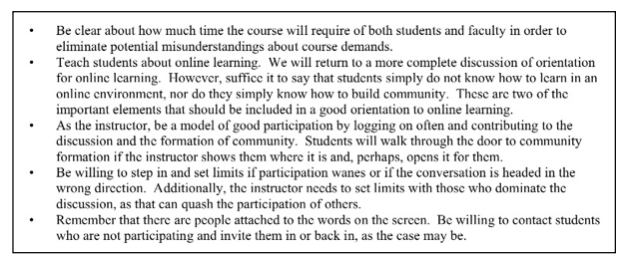Article 3
Palloff, R.M., & Pratt, K. (2005). The Role and Responsibility of the Learner in the Online Classroom. 19th Annual Conference on Distance Teaching and Learning (University of Wisconsin). www/uwex.edu/disted/conference/Resource_library/proceedings/03_24.pdf
"Simply interacting with one another is not enough" (p. 2)
Summary: The opening point is interesting and ties in with the concerns of Article 3 - “When online learning was in its infancy, the focus in the field was to orient faculty to the use of technology and how to develop an online course” (p. 1). The transition to a focus on the student and their processes of learning are the focus, concentrating on:
- openness
- flexibility and humour
- honesty
- willingness to take responsibility for community formation
- willingness to work collaboratively
A clear distinction between participation and collaboration/contribution is drawn. Asynchronous communication is recommended - partly to avoid the technical difficulties of synchronous requirements, and to allow learners to work and think in their own time. A clear set of recommendations for teachers is given (p. 3):
Evaluation: This is an excellent unpacking of the kinds of behaviours that should be expected of students who participate in an online learning environment or activity. However, the expectation are high and seem more pitched at adult learners, rather than secondary or primary students, despite the recommendation to "teach students about online learning" (p. 3) These behaviours would need to be taught and scaffolded carefully to match the abilities and age of the participants and could be considered as learning goals in themselves. The direction for the instructor to "set the stage" (p. 2) speaks to the needs for a particular learning atmosphere - but many of the points above are necessary for any group project/learning, and are not necessarily specific to online learning. The exception to this is in the discussion of how text based communication can be misinterpreted without facial cues. It would have been useful to point out the differences between offline/online learning more explicitly.
Source: As previously discussed, the authors are well published in their field, and should be considered reliable sources. The slightly chatter tone of this conference paper (compared to a journal article) does not bely the importance or academic clarity of the points they make.
Relevance and comparison to other sources: This article acts as a kind of coin-flip to the Palloff and Pratt article already discussed - focusing on the learner/learning rather than the teacher/teaching. It would be very useful for teachers setting up online learning.

No comments:
Post a Comment